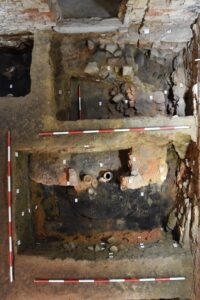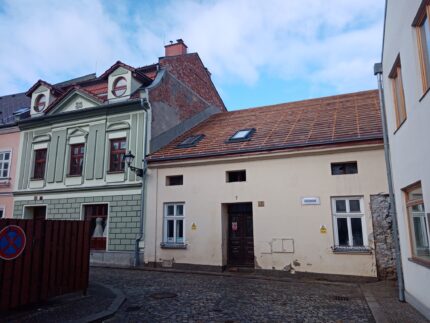 The remains of a well-preserved medieval kitchen fully stocked with clean cookware have been discovered in the town of Nový Jičín, northern Moravia, Czech Republic. The kitchen was found under a private home adjacent to the northern side of the town’s historic walls in an archaeological survey before renovation. It dates to the early 15th century.
The remains of a well-preserved medieval kitchen fully stocked with clean cookware have been discovered in the town of Nový Jičín, northern Moravia, Czech Republic. The kitchen was found under a private home adjacent to the northern side of the town’s historic walls in an archaeological survey before renovation. It dates to the early 15th century.
Based on its location, [Pavel Stabrava from the local Novojičín Museum] believes that the house would most likely have belonged to a burgher family, a social class equivalent to the medieval bourgeoisie.
“Since the house was located near the town walls, this would have been a less wealthy burgher family. The richest burghers would have lived in so-called ‘beer court’ houses around the town square.”
The stone foundations of a log house were uncovered beneath the paved courtyard of the Renaissance-era floor in the back of the house. Within the area bounded by the foundations were the charred remains of a wooden  floor. In one corner of the room was a brick oven with a raised hearth. On the hearth was a full set of cookware, complete with lids, and a wooden spatula. The dishes had been washed and put up to dry on the hearth. On the wooden floor near the furnace, archaeologists also found an iron grate, deformed by a much hotter fire than the kind food was cooked over, plus hundreds of glass beads from a necklace, a padlock, a three-tined pitchfork and a spearhead.
floor. In one corner of the room was a brick oven with a raised hearth. On the hearth was a full set of cookware, complete with lids, and a wooden spatula. The dishes had been washed and put up to dry on the hearth. On the wooden floor near the furnace, archaeologists also found an iron grate, deformed by a much hotter fire than the kind food was cooked over, plus hundreds of glass beads from a necklace, a padlock, a three-tined pitchfork and a spearhead.
The find is exceptionally rare, because city houses were renovated and rebuilt many times over the centuries, and the construction of modern utility infrastructure typically destroyed any remains of earlier townhomes under the ground. It’s a total fluke that this one kitchen survived at all, let alone in virtually untouched condition.
 The charred wood floor remains are evidence that the original medieval house was destroyed by fire, possibly in 1427 when the city was burned by Hussite forces in the Fourth Crusade of the Hussite Wars. The Hussites besieged Nový Jičín and overran it, burning the wooden buildings and massacring civilians. The kitchen and its clean cookware were probably hastily abandoned by the homeowners fleeing for their lives.
The charred wood floor remains are evidence that the original medieval house was destroyed by fire, possibly in 1427 when the city was burned by Hussite forces in the Fourth Crusade of the Hussite Wars. The Hussites besieged Nový Jičín and overran it, burning the wooden buildings and massacring civilians. The kitchen and its clean cookware were probably hastily abandoned by the homeowners fleeing for their lives.
The artefacts are now in the process of conservation, after which they will be stored in the depositories of the Novojičín Museum. Pavel Stabrava hopes that further planned excavations around the exterior of the house will reveal more about the medieval town and its inhabitants.

Here what in the 15th century in central Europe apparently has been dubbed “Greek Chicken” (No. 156, ‘Huenre von Kryechen’).
Apparently, ‘Huenre von Kryechen’ also appears in a 14th century collection from Franconia (Würzburg, 1345-1354AD).
The original reads “wine or vinegar” (‘vnde win oder ezzig’) and ‘yngeber’ for ginger. The original ends with ‘cook it all together, serve, and do not oversalt it!’ (…vnde versaltzez niht).
Otherwise, you probably needed indeed a well established down-town ‘beer court’ and also rather good ‘connections’ in order to get some medieval ginger root. I can report, however, that in modern times there is indeed ginger harvested in Franconia.
1 chicken
500 g pork
1 teaspoon ginger (hacked?)
1 tablespoon honey
1/8 liter dry white wine
salt, pepper, rose petals (“vierdunc rosen”, a “quarter”)
Fry or roast the chicken and pork one by one until done. Cut the pork into morsel-sized pieces.
Make a sauce with ginger, honey and wine, season with pepper and boil briefly.
Arrange the chicken on a platter, arrange the pork pieces in a circle around it and pour the sauce over it. Sprinkle with rose petals as decoration.
:chicken:
———
The “buoch von guoter spîse” is found on pages 156r – 165v as the 21st chapter in the “Housebook of Michael de Leone”, referred to in older research as the “Würzburger Liederhandschrift”. It is assumed that the ‘Book of Good Food’ was written by the main scribe B, to whom 200 of the 285 leaves of the second volume are attributed. Behind the corrections, which clearly stand out from the rest of the text due to their black ink, one suspects Michael de Leone (around 1300-1355)…
———
In the late Middle Ages, the term “beer court” was describing a residential building, the ownership of which was linked to the right to brew beer. Thus, the right to brew was not tied to a person, but to a piece of land. This gave the property a higher value.
The number of beer courts was limited in most towns, so that brewing beer provided its owners with a secure and often high income. This was also ensured by the municipal beer ordinances that largely excluded mutual competition between the “beer courts”. They stipulated for the entire year which brewery was allowed to brew how many beers and when.
“One beer”, for example, meant a larger quantity, usually several large barrels. Often, the beer yards in a town had different brewing rights, i.e. there were some with four, eight, or some with even twelve or more “beers”.
However, those “beer courts” were usually not the actual brewery.